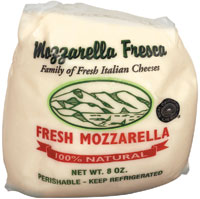Mozzarella Fresca Increases Capacity with Existing Equipment
 Headquartered in Concord, Calif., Mozzarella Fresca Inc. produces award-winning fresh mozzarella, marinated fresh mozzarella, ricotta and mascarpone cheeses, and boasts an "unwavering" focus on quality and customer service.
Headquartered in Concord, Calif., Mozzarella Fresca Inc. produces award-winning fresh mozzarella, marinated fresh mozzarella, ricotta and mascarpone cheeses, and boasts an "unwavering" focus on quality and customer service. All Mozzarella Fresca products are 100 percent natural, certified Kosher and free of preservatives, additives, gluten, transfat and hormones. The company's products are available nationally in most retail stores and are found in many of the top restaurants' appetizers, entrees and desserts.
Supply Chain Challenges
Because Mozzarella Fresca's cheese is shipped and sold fresh, it has a relatively short shelf life - between 35 and 120 days - including time in transit. Mozzarella Fresca typically ships its cheese anywhere from a few hours to a couple days after it is produced. Not surprisingly, the company is constantly faced with the challenge of scheduling the production of multiple products so that they can be shipped as quickly as possible to maximize the shelf life.
Creating additional challenges for scheduling is the fact that Mozzarella Fresca's business has grown by 25 percent year after year. This sustained growth meant either investing capital in new equipment for expanding the plant, or increasing capacity with existing equipment.
Mozzarella Fresca decided to try the second option. The company enlisted Supply Chain Consultants' Zemeter Scheduler solution, which enabled Mozzarella Fresca to create capacity in its plants by optimizing its scheduling process without investing in new equipment.
How Cheese is Made
The cheese-making process begins when Mozzarella Fresca receives milk shipped in tanker trucks from nearby dairy farms in Tulare County, Calif. The milk is stored in tanks and pasteurized for cheese production. Pasteurized milk is put into large Jacuzzi-sized tubs called chariots, where acid or culture is used to curdle it. The curds are then dumped into a cooker-stretcher to stretch the cheese for mozzarella's characteristic stringy texture. Cheese is then molded into logs or one-third ounce to four ounce balls. The molded cheese spends anywhere from 15 minutes to 90 minutes, moving through a cooling canal of cold water, and is then packaged into tubs, vacuum-packed wraps or bags. The packaged cheese is stored in a refrigerated warehouse for up to a few days.
Ensuring Freshness
Historically, Mozzarella Fresca was using a spreadsheet-based model developed in-house; planners could not put constraints on the multiple variables that the company has and still come up with an optimal schedule.
Lawrence M. Leser, chief financial offer, Mozzarella Fresca says, "We tested against our current solution and found that it was not humanly possible to create an optimized schedule with our number of SKUs and the necessity to have the product ready in a short period of time. We needed a model that enables us to manufacture a product that gives the customer the freshest cheeses possible, and Zemeter allows us to optimize the schedule necessary to meet that objective."
Order demands at the customer level and the ship-to date are inputted from Mozzarella Fresca's business systems to Zemeter, which then processes data on the day the product is to be picked up at the company's plants, the time the product is scheduled to ship from the plants, the item code and the quantity.
Zemeter analyzes the demand, then the software's Mixed Integer Linear Program (MILP) is used to determine what products should be produced on any given day and in what order.
The solution optimizes the manufacturing schedule from the molding process all the way through to packaging. As a result, Mozzarella Fresca has been able to add 15 percent capacity, while at the same time, the company has reduced its per unit labor cost by approximately 15 percent. Although savings in labor was not one of Mozzarella Fresca's key objectives, it quickly became evident that with a more efficient schedule the workforce also tends to be more productive.

